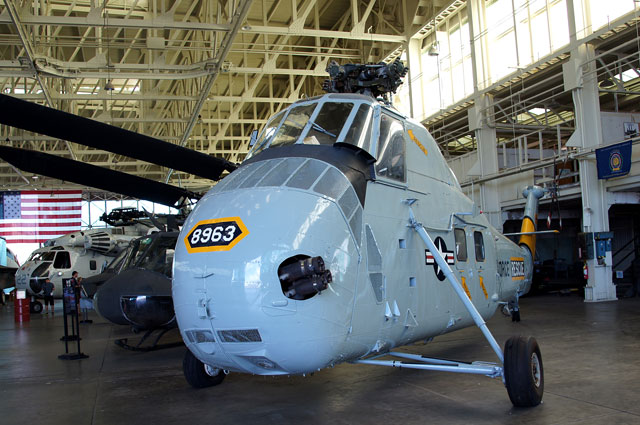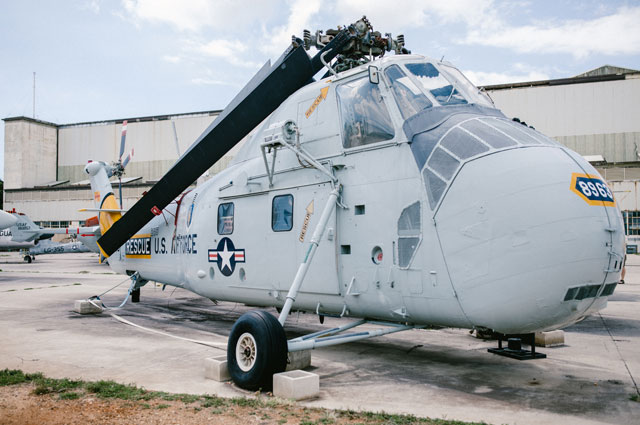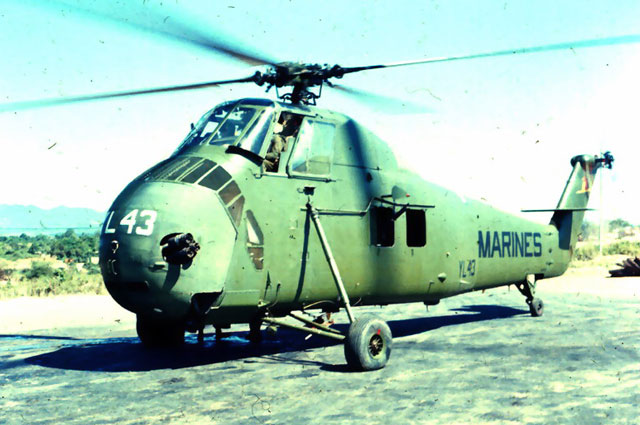
Sikorsky HH-34J Choctaw (ASW & Transport)
Snapshot
- Nickname:
- Choctaw
- Number Built:
- 2,108
- Make:
- Sikorsky Aircraft
- Mission:
- ASW & Transport
- Location:
- The Raytheon Pavilion & Outdoor Exhibits
Background
With its distinctive hump, the H-34 is one of the most recognizable helicopters. It was among the last of the piston-engine ones. In Algeria and Vietnam it pioneered new roles for helicopters in war: troop assault, gunship, and cargo hauling.
How do you make a helicopter bigger? Piasecki/Boeing used twin rotors at the front and back of the helicopter, driven by a single engine in the back. (Like a flying banana.) Sikorsky kept the rotor in the middle of the aircraft, at its center of gravity, and placed the engine in the front. Although these are 1950s designs, the patterns continue. Sikorsky’s H-34, SH-3, and the CH-53 retained the single-rotor, and Piasecki/Boeing’s H-46 and H-47 had two. One change with the H-34 design is the tail-dragger rear fuselage and landing gear.
To lighten the aircraft, parts of the H-34’s skin were made of magnesium, which corrodes in salt air, so the Navy and Marines had to wash it often. Also, magnesium burns easily, and the crew is quite vulnerable sitting 15’ above the engine.
UH-34B Seabats served as recovery birds for early Mercury space flights. Its lift capacity was just enough to carry the space capsule. In 1961, the Mercury 4 hatch was prematurely opened and the capsule filled with seawater. The extra weight was too much for the H-34 and the capsule had to be released and sank in deep water.
Initially it was called the HSS-1 Seabat (anti-submarine) and HUS-1 Seahorse (transport) by the Navy, Marines and Coast Guard. The Army and Air Force called it H-34. In 1962, under the unified DoD aircraft designation system, the Seabat became SH-34, the Seahorse UH-34, and the Choctaw CH-34.
Roles included utility transport, anti-submarine warfare, search and rescue, and VIP transport. It could carry 12–16 troops, or eight stretcher cases and two medical personnel in the Medevac role.
The U.S. Army did not fly the Choctaw in Vietnam, but the Marines depended on the CH-34D “Dogs” for combat assault in Vietnam from1962–69.
Originally purchased by the Navy as an anti-submarine warfare (ASW) helicopter. It was retired and sent to the boneyard at Davis-Monthan. However, some Air Force Reserve units needed search and rescue helicopters in 1972, so the Air Force refurbished them. They removed ASW equipment, but they still had auto-hover capability, making them ideal for rescue work. The Air Force designated them HH-34Js. Although they served well, they only served for three years. In 1974, the Air Force retired them again and sent them back to the boneyard or gave them to museums. They were the last H-34s to fly. Ours was displayed at the Museum of Aviation at Robins AFB before coming to Pearl Harbor Aviation Museum in 2013.
Please visit our “Sikorsky H-34 Choctaw/Seabat/Seahorse” blog post to learn more about this aircraft.
Specs
- Contractor
- Sikorsky Aircraft







